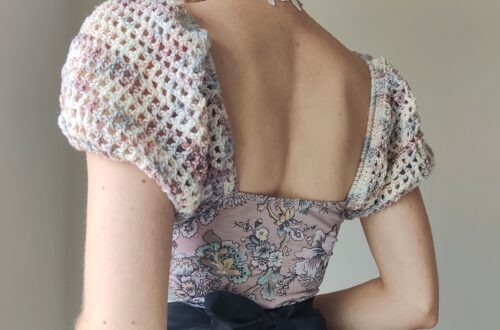Cross Stitch Patch + Free Pattern (QUOE TIPS)
 Recently, I have discovered a love for the one craft that I never thought I would take part in; Cross Stitch. Something about the meditative cross-hatching of threads is a major de-stressor for me, and I can use it as a way to clear my mind while creating a useful product! Of course, being as I always stress to ”break the status quo”, I have already begun my own personal process of creation that strays from the norm. Using these steps, I’ve created a system for making perfect cross stitch pieces that serve as fully functioning patches! Along with my tutorial today, you’ll also find the free chart for this custom patch that I created as an homage to one of my favorite Clover products; their Jumbo Locking Stitch Markers!
Recently, I have discovered a love for the one craft that I never thought I would take part in; Cross Stitch. Something about the meditative cross-hatching of threads is a major de-stressor for me, and I can use it as a way to clear my mind while creating a useful product! Of course, being as I always stress to ”break the status quo”, I have already begun my own personal process of creation that strays from the norm. Using these steps, I’ve created a system for making perfect cross stitch pieces that serve as fully functioning patches! Along with my tutorial today, you’ll also find the free chart for this custom patch that I created as an homage to one of my favorite Clover products; their Jumbo Locking Stitch Markers!
Let’s get into it!
Supplies:
- Embroidery Hoop (Small)- Art No. 8813
- Sashiko Needles (Long)- Art. No 2009
- Yarn Threader- Art. No 3142
- Wonder Fuse- Art. No 4090
- Patchwork Scissors (Mini)– Art. No 493/CW
- 14 Count Aida Fabric
- Iron/Ironing Board
- Misc. Lace to Fingering Weight Yarn
- Cross Stitch Chart (below) – Download Pattern PDF


Setup:
To begin, loosen embroidery hoop and separate pieces. Place bottom hoop section under corner of Aida fabric and place top hoop section over, sandwiching the fabric between. Pull fabric taut. Tighten hoop while making sure to keep fabric tight around the bottom hoop section. Once your fabric is secure, cut away excess fabric as close to hoop as possible. Thread Sashiko needle using yarn threader with whatever yarn you would like to start with. I always start with the border, so I have chosen the corresponding color. Double your yarn and don’t knot the end. Now we are ready to start stitching! 


Begin Cross Stitch:
To begin stitching, place your first stitch around the bottom left-hand corner of your work. Pass needle through the wrong side of work at one of the crosshatched holes. Pull yarn through, leaving an approximately 2” tail at the back. We will only be using a right-leaning half stitch for the entire project. Pass needle through crosshatched hole directly diagonal to previous hole (refer to photos). 



Outlining Border:
Once you have successfully created your first stitch, you can begin outlining the border. Refer to chart to see how many stitches are required. For this pattern, the grid is 30 stitches by 30 stitches. Repeat the process of your first stitch directly to the right of previous stitch until you have completed every stitch across. Once finished with your first row of stitches, begin your righthand column, working around the border in a counter-clockwise motion. 



Working New Yarn:
After a few stitches are completed, you can trim down the tail end of working yarn to approximately 1/8”-1/4” if you are using Wonder Fuse to finish the back. Once you can no longer comfortably stitch, trim end tail to beginning tail length, and repeat the starting process with new yarn. I find about a foot of doubled yarn is long enough to work with for a while without needing to fasten off, but short enough to not be a hassle when stitching. 


Continuing:
Once your border is complete, you can begin filling in the inside. You will find it much easier to work from the outside in because you now have a reference point for exactly where each stitch should go. Work chart as graphed following all above directions. Don’t be afraid to play with textures. For the dark section of the stitch marker, I used a lace weight mohair that gave it a shadowed effect. You may also wish to fill in the background, this is optional. Once the chart is complete, you can move on to turning it into a patch! 




Finishing:
Start by cutting around your border stitches. I give about 7-8 crosshatch holes space when cutting, as we will be folding in the raw edge. Clip your corners. Place patch right side down on ironing board over scrap fabric. Fold over raw edges to wrong side of patch and iron until flat. Flip patch and iron right side to set stitches in place. Now trace around Wonder Fuse sheet and cut to exact shape of patch. Follow Wonder Fuse package instructions to adhere to cross stitch. Do not pull off paper backing until you are ready to use your patch! Flip to right side and trim any threads, yarn, or excess Wonder Fuse backing to complete your patch. 




 We finished our cross stitch patch! I can’t wait to see all of the things they are used to patch up, or see you folx applying the same principals for other cross stitch patterns! Be sure to tag Clover and me in any posts so we can see what you create. Stay tuned to the blog for next week’s post, where I will go over creating a handful of useful knit and crochet patches!
We finished our cross stitch patch! I can’t wait to see all of the things they are used to patch up, or see you folx applying the same principals for other cross stitch patterns! Be sure to tag Clover and me in any posts so we can see what you create. Stay tuned to the blog for next week’s post, where I will go over creating a handful of useful knit and crochet patches! 
Catch up on the Series
- 5 Ways To Sew Patches Perfectly
- English Paper Pieced Floret Patch
- Cross Stitch Patch (This Post)
- Knit & Crochet Patches
- Sewing a Patched Project Bag
Follow what Quayln is up to next on his Blog | Instagram | Facebook | Pinterest | YouTube | Ravelry
Stay connected with Clover on Facebook | Twitter | Instagram | Pinterest | YouTube | Ravelry
[mc4wp_form id=”11289″]


